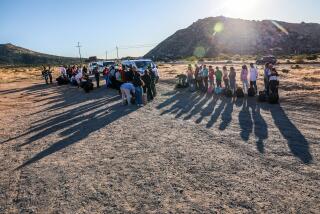Study Targets Diabetes Along Mexico Border
A groundbreaking binational study of diabetes on the U.S.-Mexico border aims to protect a population especially at risk of contracting the disease.
The five-month study, headed by a Texas-based public health group, hopes to determine the prevalence of diabetes along the border and to create treatment and prevention programs.
Residents along the border were chosen because previous studies have found rates of death and illness because of diabetes there “are two or three times higher than in any other place in both countries,” particularly among Latinos, said Oscar De La Riva, coordinator for the study in California.
About 10% of 11 million people living along the border have diabetes--twice the national figure, study organizers say. And the number of cases on the border is rising every year by 5%.
Ethnicity is a major factor. Diabetes is particularly prevalent among Mexican Americans, and about 70% of border residents are Mexican or of Mexican ancestry, said project coordinator Gerardo de Cosio of Pan American Health Organization in El Paso, which is leading the project.
A second factor increasing diabetes risks at the border is poverty, which leads to malnutrition and limits access to health care, De La Riva said.
Nationally, about 15 million Americans have diabetes. Last year, it cost $25 billion to treat diabetes, study organizers say.
The $1-million study is part of a five-year project involving state, federal and nongovernmental agencies. The California study, funded by the nonprofit California Endowment, will begin March 5, with studies in other states following in a few weeks.
The study will also look at what kind of access border residents have to health care and how many are aware they have the disease. Study organizers estimate that more than a third of those who have diabetes along the border don’t know it.
Chula Vista resident Manuel De Leon, for example, had no idea he had diabetes before a life-insurance physical exam several years ago turned up the diagnosis, said his wife, Irene.
The auto-repair shop owner is the latest of several in his family to be diagnosed, she said. The disease also afflicts his mother and two brothers and took the life of his sister last year. All live along the border.
The study will focus on Type 2 diabetes, afflicting 90% of American diabetes patients. It is characterized by a decreased output of insulin and a reduced ability of cells throughout the body to respond to insulin’s effects.
The treatment and prevention programs will consider culture.
“It’s important to have a healthy diet and exercise,” de Cosio said. “But you don’t want to tell them, for example, not to eat tortillas.” Instead, health workers would advise residents to limit how many they eat and to find healthful ways to prepare meals.
The border states involved in the study are rural and urban areas in California, Arizona, New Mexico, Texas, Baja California, Sonora, Chihuahua, Coahuila, Nuevo Leon and Tamaulipas.
About 4,400 people, including 644 in California, will be surveyed.
During the second through fourth years, treatment and prevention programs will be implemented. The programs will cost $500,000 each year for four years, de Cosio said. In the fifth year, another study will be conducted to determine the program’s effectiveness.
More to Read
Sign up for Essential California
The most important California stories and recommendations in your inbox every morning.
You may occasionally receive promotional content from the Los Angeles Times.










